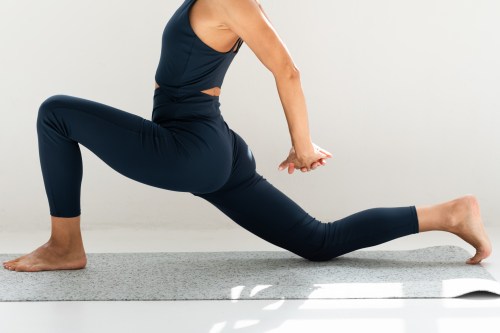When it comes to maximizing your fitness gains, it’s not just enough to do one type of workout, like running or yoga, or to focus solely on a specific muscle group. Instead, you should be targeting the whole body and working on integrating variety and different styles of training into your routine so you can continually shock your body and get some pretty mean results.
How might these different methods work? Well, you can think of them as being “opposites,” like doing active or passive recovery post-workout or choosing a HIIT class over a LIIT class (the former being high-intensity and the latter being low-intensity). And your best bet at leaning out and getting strong all over is by using both models together for an efficient workout and optimal recovery. If you’re not totally sure how to blend them—don’t worry—here’s a breakdown to doing both methods like a champ.
Active and passive recovery
Active recovery might be for LIIT days, where you’re choosing an activity that’s of a lower intensity to let your body recover while still getting in a workout or where you might try low-impact moves post-workout to cool down, explains Jackie Vick, CSCS, a trainer at Gold’s Gym.
“Active recovery movements during lifting take the focus off the primary movement. In strength workouts, if the focus is deadlifts and the workouts have double-unders then the double-under is the recovery,” she explains. For cardio-based active recovery, reducing the gear (or speed) in preparation for another interval is a form of active recovery.
Active recovery is extremely important mid-workout to maximize output over time, where you’re keeping blood flowing to the muscles during those rest periods. Passive recovery, on the other hand, is taking a day off for complete rest or stretching, rolling out, or doing mobility drills such as, in-step stretch or foam rolling a region that you targeted, she says.
When it comes to doing both, timing is how you choose. “Active recovery should be incorporated after each heavy lifting session or each high intensity interval to maximize output over time,” she says. If you’re doing a HIIT routine, “active recovery should occur multiple times throughout the workout, mostly after each set or round depending on the style of the training (functional, weight training, or cardio based),” she says.
Passive recovery is just as important, if not more, as active recovery because it allows muscles fibers time to re-build appropriately. If time is not given, you’ll tear down muscles, leading to less strength, increased injury risk, and less endurance.
Compound and isolated movements
“Compound movements, such as the power clean or deadlift, are full-body movements incorporating multiple muscle groups into a single lift. Isolated movements, such as the bicep curl, use a single muscle group to achieve a concentrated effect on that region,” she says. Knowing how to use both in your workouts will take your training to the next level.
Here’s how to do both: A power clean is a perfect example of an explosive compound movement designed to help train the fast-twitch muscle fibers. It targets the legs, glutes, hips, core, lower back, arms, and upper back all in one motion. (Yeah, it’s pretty killer.) Do a set of power cleans and then go for a set of an isolated movement.
Bicep curls or tricep extensions are isolated movements concentrating energy into working one group of muscles, rather than whole body, so you can definitely do one of these to follow the cleans. “Isolated movements are generally used one side of the body at a time, meaning you will train the right bicep followed by the left,” she says.
Be careful of timing—always start with the compound move first and move to isolated after, as you might become too fatigued to tackle the complexity of the compound move and give it your all.
Solo and group training
Solo training is all about you—in your own world, crushing your workout. It’s pretty meditative and you can focus on your own improvements. Group training provides a positive and competitive environment to push yourself and feel the bond. Obviously both are great, as long as you find a workout that keeps you motivated.
Yet try and do both if you can. “A combination of both leads athletes to their goals quicker, due to the positivity and encouragement from others while allowing time for athletes to train on their weak areas to eventually out perform their fellow classmates,” she says.
Timing and spacing is up to you. “Some perform better in positive group environments while others flourish focusing on their own personal training plan. I recommend following the path that motivates and drives you to be a healthier person; doing so will keep your fitness journey moving forward while hopefully making some life-long friends along the way,” she says.
HIIT and LIIT
“High intensity interval training, or HIIT, combines short peaks of work followed by periods of rest to achieve a physiological effect known as EPOC (excess post-exercise consumption) that allows the body to burn calories long after you’ve stopped working out,” she says. So, it’s pretty awesome, but you can’t do it everyday.“LIIT, or low intensity interval training, is a method of training endurance or reducing intensity for active recovery days using steady state or low resistance exercises,” she says.
How might they differ? It’s all about types of interval moves and the length of breaks in between intervals. LIIT can still be interval training but with longer rest periods and not nearly as intense intervals. So, both get your heart up, but with LIIT, just not as much and with less impact. HIIT brings your heart rate to the high cardio zone, while LIIT brings your heart rate to low cardio zone, she explains.
“I recommend separating the two training types over different days to achieve the intended effect from each,” she adds. And no more than two or three days a week of HIIT or LIIT.
“Each form of interval training has its individual perks. HIIT training can be performed under condensed timelines, offering the same result as LIIT training. LIIT training can offer the same caloric burn with lower impact movements by extending your workout from 30 to 45 minutes to one hour,” she says. By using both, you’ll lower risk of injury and be gentler on your body, while still getting some killer results.
Trainers share the secret to working out smarting, not harder. And this is what happens when you skip a week of exercise.
Sign Up for Our Daily Newsletter
Get all the latest in wellness, trends, food, fitness, beauty, and more delivered right to your inbox.
Got it, you've been added to our email list.











